Sound: 









Value: 









(Read about our ratings)
Measurements can be found by clicking this link.
 There’s a belief, common among TV watchers, movie watchers, and apparently people in general, that headphones are magic. That wearing literally any pair of headphones makes you completely oblivious to the world around you. That headphones are able to create a fantastical cone of silence where no reverberations penetrate. If only, am I right? Even the best noise-canceling headphones still let in some sound. Now sure, if you combine high music volume, solid noise canceling, and decent passive reduction, you can get pretty close to this magical ideal. But it’s still fantasy to think slapping on a pair of headphones can really isolate you from the real world. Or at least it was.
There’s a belief, common among TV watchers, movie watchers, and apparently people in general, that headphones are magic. That wearing literally any pair of headphones makes you completely oblivious to the world around you. That headphones are able to create a fantastical cone of silence where no reverberations penetrate. If only, am I right? Even the best noise-canceling headphones still let in some sound. Now sure, if you combine high music volume, solid noise canceling, and decent passive reduction, you can get pretty close to this magical ideal. But it’s still fantasy to think slapping on a pair of headphones can really isolate you from the real world. Or at least it was.
I don’t want to oversell the performance of the Bose QuietComfort Earbuds II earphones ($299, all prices USD), but the noise canceling is otherworldly. I’ve been reviewing noise-canceling headphones and earbuds for over a decade, and the Earbuds II are so good I didn’t think noise canceling could be this much better. And if you’re already doubting my superlatives, click over to Brent’s measurements. These earbuds really are that good.
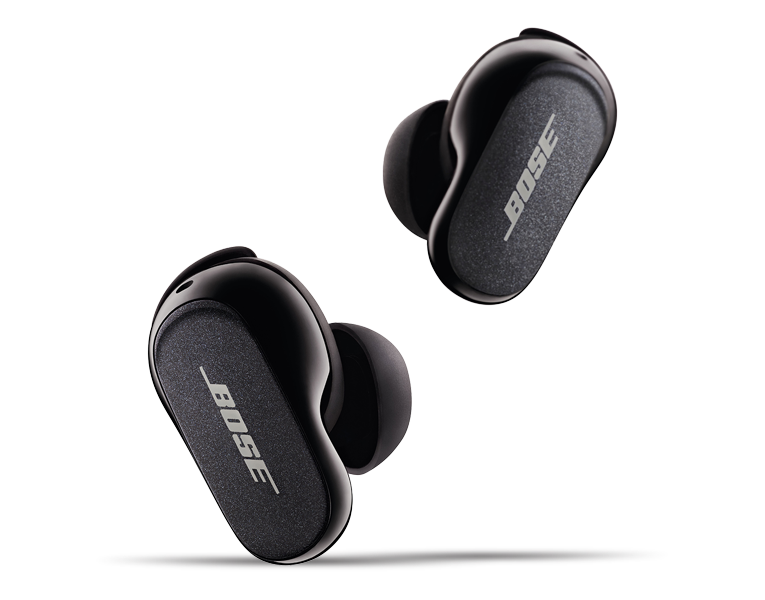
Other than the noise canceling, the Earbuds II earphones are . . . fine. OK, more than fine. Quite good, but definitely not perfect. It seems all the engineering effort and money has gone into the noise canceling, and Bose has skimped on several features that seem oddly missing here. In fairness, the headphone-quality curve has been blown by the noise canceling. It’s so good that everything else seems lesser by comparison. Like, there’s no multi-point Bluetooth connection, there are some connection/app issues, and the earbuds are only IPX4 rated. Not that big of a deal, but these are $300 earphones. That said, for a lot of people, these are the only earphones they’ll ever need.
In the box
There’s less inside the QuietComfort box than you might expect for $300 earbuds. Just a USB-A-to-USB-C cable, some documentation, and Bose’s Fit Kit. Props for the rhyme, Bose. Bravo. The Fit Kit surprisingly only comes with three silicone tips and three silicone “stability bands.” These help secure the earbuds better in your ears.
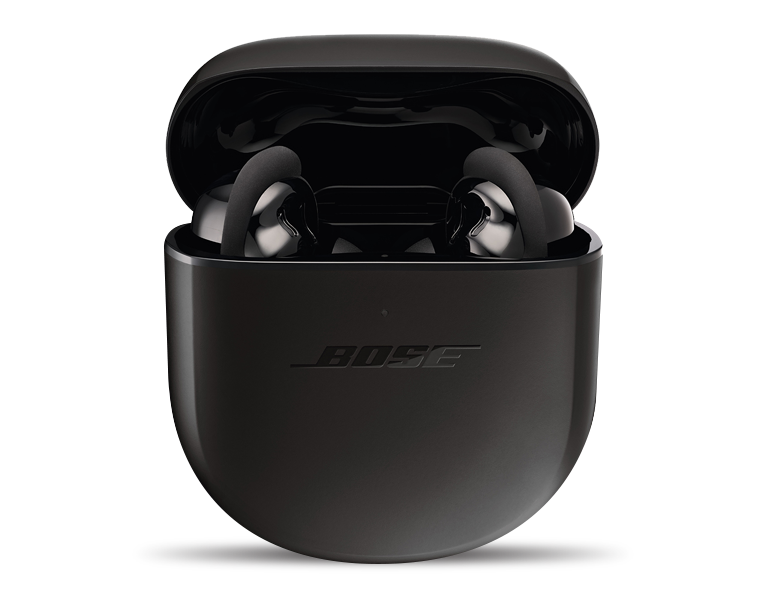
Use
Despite the fact that they come with only three tips and three stability bands, I was able to get an excellent fit with the QCEIIs. That’s more impressive than it sounds. I have fairly small ear canals but average-sized ears, so most earbud tip/fit options have one size that will fit one part of my ear well, but will be loose on another.
This is one of the reasons I love my aging B&W C5 earbuds. They have a loop that secures the earbuds to the inner part of my outer ear (called the concha) without adding undue pressure on my diminutive ear canals. This is basically what the Bose stability bands do. They add a securing contact point separate from the body of the earbud that doesn’t rely on friction from the tips. Out of the box, the QCEIIs come with the medium tips and small bands attached. This is probably what the average adult man will prefer. These fit me fine, but when I swapped in the small tips and the medium bands, they fit better than any true wireless earbuds I’ve ever tested. At least those without over-ear loops. I never felt the QCEIIs would fall out of my ears, even when moving around energetically.
Which isn’t to say you should use these while working out. They’re IPX4, which should be fine for sweat and occasional splashes of water, but if you’re considering workout earphones, I recommend the Soundcore Sport X10s instead, not least because they’re less than 30% of the price.
The Bose Music app has the aesthetic polish you’d expect from a company like Bose. It’s pretty much entirely black and white, and feels quite . . . adult. No funny business here. No flashy colors or any kind of pomp or circumstance. That would be downright unprofessional.
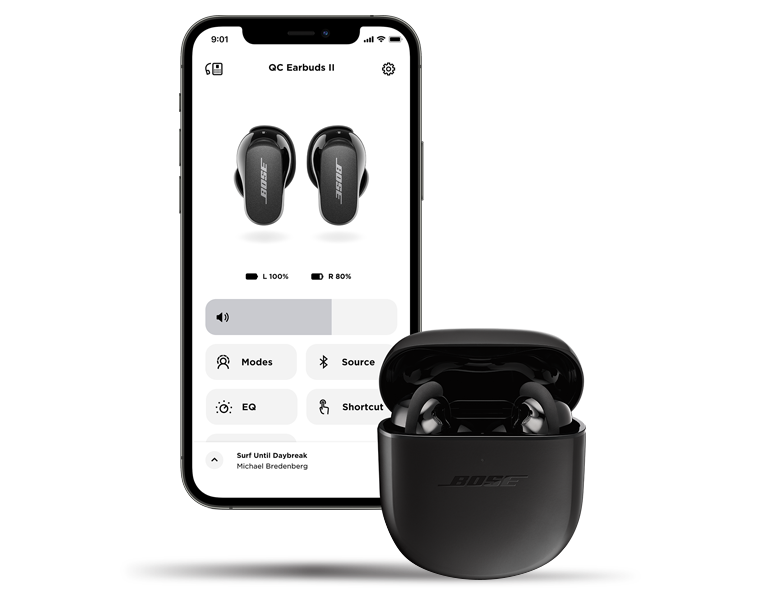
The cutesiest aspect is that you can name your earbuds, either by typing your own idea or using one of Bose’s pre-written options like “Fort Rocks,” “Penguin,” “Sea of Tranquility,” and so on. With such ostentatious options like “Bass Bumpers,” I decided it was only fair to treat this choice with the staid, mannerly reverence the app implied, so I chose “Bose QC Earbuds II,” like a grown-up. Later I changed them to “i like butts lolz.” Like a grown-up.
There are four EQ presets, simply labeled Bass Boost, Treble Boost, Bass Reducer, and Treble Reducer. You can further tweak each preset via a three-band graphic EQ, offering +/- of Bass, Mid, and Treble. The amounts aren’t labeled, so they could be +/- 10dB, or they could be joules or maybe pandas. We have no way of knowing. Probably safe to assume dB, I guess. Visually, they look like broad low and high shelves, with a wide Q for the midrange, though at what specific frequencies the ramps start is unclear.
Noise canceling is controlled via Modes. You can create and save four Modes, each with its own preset NC amount. This might seem a little excessive, but consider that this is by far the most noise canceling you’ve ever heard, and there are plenty of situations where the maximum might be too much. A simple slider would have probably sufficed, but that would be harder to adjust using the touchpads on the earbuds.
Speaking of, you can swipe up and down on each earbud to change the volume, and tap twice or thrice to skip forward or back between tracks. You can’t customize these, which is weird. You can customize what happens when you press and hold an earbud, with two options for each ear: either cycling through the saved Modes or activating your voice assistant.
Bose makes a big deal out of its new tech, CustomTune. By playing a symphonic sound every time you place an earbud in your ear, Bose claims it calibrates to your specific ear canal. Since there’s no way to turn it off, it’s impossible to say what effect, if any, this has.
Surprisingly missing is a multi-point Bluetooth connection, which would let you more easily swap between your phone and laptop, for instance. This is fairly common among higher-end Bluetooth headphones/earphones, and its absence here is notable.
The lack of multi-point isn’t the most disappointing omission, however. Being Bluetooth earbuds means there’s no way to connect the QCEIIs to an in-flight entertainment system. NC headphones are a must-have for most travelers, myself included. You could easily argue that this was what put Bose’s original NC headphones on the map. With no way to connect, you can’t enjoy all those stale movies and TV shows many flights offer. You’re essentially forced to bring your own shows/movies to watch on the plane via your phone/tablet/laptop. Not a huge dealbreaker, I suppose, but this was a feature I was definitely expecting. The powerfully mediocre but admittedly feature-rich LG Tone Free T90Q earphones have a feature that turns the case into a Bluetooth transmitter, letting you connect to any analog audio source and still use your earbuds. A similar feature would have been an obvious inclusion here, but nope.
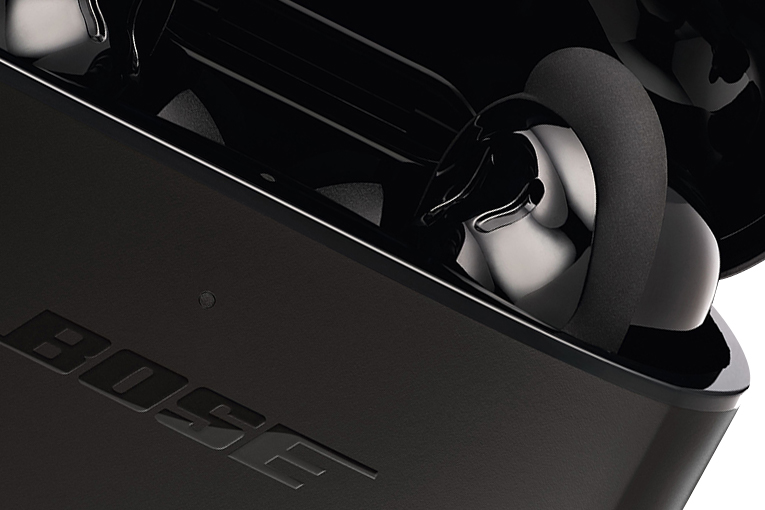
Lastly, for such a big company and such a relatively expensive product, wow are there connection issues. Getting them connected to my phone, and then the app, was a mild struggle at first, and it continued during the course of the review. Worse, they occasionally cut out momentarily or had bursts of static during playback. Sometimes they’d connect to my phone, and they’d work, but the app couldn’t find them. I’m rather shocked that a huge company would release something for $300 that had these problems. I started my review in mid-October, so they’d been out for over a month and were still having these issues despite having the latest firmware. I assume Bose will get around to fixing these issues, since they’re likely all software-based, but I’m actually quite surprised.
Sound
Overall the sound of the Bose QuietComfort Earbuds IIs was perfectly pleasant. They have a fairly neutral sound profile. There’s a bit of a bump in the midbass, and they’re fairly clear in the high end. They sound better than the Bose QuietComfort 20s I’ve used for years, and have none of the typical vices found with many earphones. It’s a conservative tuning that is unlikely to wow anyone, but no one’s going to hate it either. A tuning aimed dead center on the beige-wearing masses.
For example, they lacked deep bass. Now I’m known as a bass fanatic, or as I’d prefer to be called, a bass connoisseur. But even if I cranked up the bass in the EQ, it went only so low and got only so loud. Like a pair of small bookshelf speakers without a sub. That’s not inherently a bad thing; what bass was there was fairly well-controlled and not boomy. A few pipes missing from the organ, so to speak.
So, for instance, Widor’s Symphony No. 5 in F Minor, Op. 42, No. 1 for Organ 5. Toccata (Vierne, Widor, Reubke: Organ Works, 16-bit/44.1kHz FLAC, Deutsche Grammophon / Tidal) lacked some of the piece’s big pedal tones and therefore missed some of the grandeur. However, there were no notable, undesirable peaks in the response, so there was nothing unpleasant about the sound. I could turn up the bass in the EQ and there was definitely more bass, but it still lacked the lowest tones and got rather muddy.
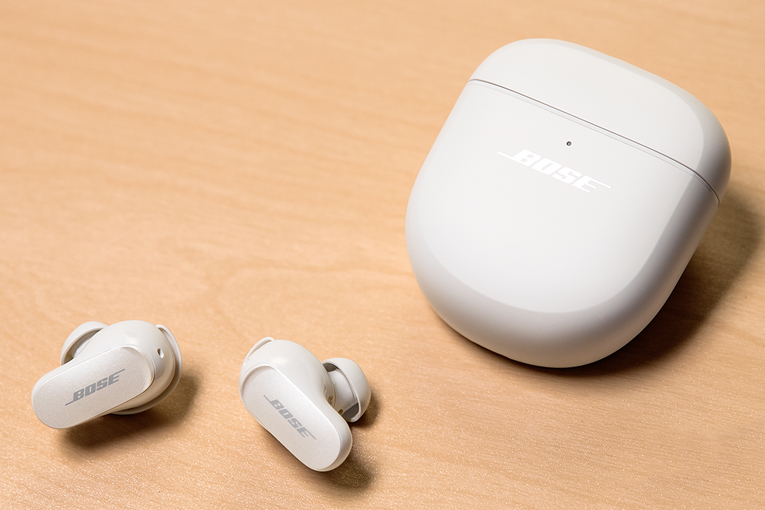
Or take the bouncing “Buddy’s Bounce” by Take2 (Take2, 16/44 FLAC, Outrageous8 Records / Tidal). It felt like I was in a small hall, right up near the stage. The impressive basslines on this album came through well, with solid definition. The sound was never mushy. There was a nicely wide soundstage, which is welcome when you’re well cut off from the rest of the world sound-wise.
The higher frequencies got the same treatment. Carly Rae Jepsen’s “Beach House” (The Loneliest Time, MQA, Interscope/Tidal) has a huge and complex layering of synths, percussion, and voices. It would be very easy for the treble in this track to get very unpleasant. Instead, while it didn’t quite have the openness or detail of some better-sounding earphones, it wasn’t piercing either. It’d be very easy to listen to the QCEIIs for a long time, even at higher volumes.
I stepped back a few decades and queued up “Tangerine” (Led Zeppelin III, MQA, Atlantic/Tidal). It, too, has many layers. It made me wonder if I’d been too harsh on the QCEIIs. This track’s many guitars, mandolin, and pedal steel all came through clearly, never getting overwhelmed or overshadowed by Bonham. Page’s vocals were a little bit back from where they should have been, but not badly.
Which is all to say, the QCEIIs’ sound was good, not quite great. And it will likely be well-liked, not quite loved, by most people.
Comparison
Comparing the Bose QuietComfort Earbuds IIs’ noise canceling to other earphones would be like setting up a race between Usain Bolt and, say, me. You could give me a five-minute head start and he’d still beat me to 100 meters. Brent’s measurements will tell a detailed story, but for my subjective testing, I felt the best comparison would be to the QuietComfort 20s I’ve used as a noise-canceling benchmark for years. They were, until recently, vastly better than everything else on the market.
The QCEIIs are as much better than the QC20s as the QC20s were to everything else when they came out (and years after). In the airplane-engine noise region, down around 200Hz, the QCEIIs definitely cut out even more noise. But that’s like saying Art Tatum was impressive because of what he could do with his right hand. It was his left that was insane. Improving low-frequency noise canceling is no doubt impressive, but what Bose has been able to accomplish in the midrange is remarkable. Bose is cutting more midrange frequencies than other still-excellent noise-canceling headphones can do in the low end, where it’s easier to reduce noise.
So yes, in a noisy environment where NC earphones typically excel, like an aircraft cabin, train, bus, and so on, the QCEIIs were even better than the excellent QC20s and likely everything else on the market today. But in the type of noisy environments where other NC earphones don’t do much, if anything, like with voices and the normal daily clamor, the QCEIIs remarkably drop that to such a degree that they’re as close as we’ve gotten to a portable isolation chamber. They’re really that good. Not silence, of course—that’s still impossible, but the QCEIIs are the first NC earphones where putting them on really did make me feel separate from the world in the way that Hollywood and apparently most people think headphones actually work.
Sound-wise, the QCEIIs were better than the QC20s as well, though that’s not saying much. Bose hadn’t quite gotten their flat-ish tuning nailed down at that point, so the QC20s were borderline boring. The QCEIIs were likely designed with similar intent, but they succeed better at it. They’re more interesting to listen to. There are more (and clearer) highs and fuller bass.
To compare the QCEIIs to some mere mortals, I swapped in the Edifier NeoBuds S earphones I reviewed recently. They had very good noise canceling, plus I adored their sound. Their app’s EQ also offered far more flexibility to fine-tune the sound to your liking. Even without using the EQ, the NeoBuds had a more exciting sound. There was stronger, deeper bass and clearer treble. Since both highs and lows were reproduced well, with no boom on the low end or sizzle on the top end, the result was a far more appealing sound. I greatly prefered the NeoBuds’ sound, and in most situations I’d find their level of noise canceling acceptable. Impressive for a little more than half the price of the QCEIIs. That said, if I were headed for a long flight or ride and NC were my priority, I’d still take the Bose earphones.
Conclusion
On the one hand, the QuietComfort Earbuds II earphones are a flat-out remarkable product. The noise canceling is once again class leading. I didn’t think NC could get this much better than the still-excellent QC20s. The fit, at least for me, was perfect in a way I’ve rarely experienced with earbuds. The sound, while not 10/10, is still quite excellent.
However, some features are strangely missing, and there were bugs and quirks in the software during testing that are really quite embarrassing for a mainstream product from a mainstream company. I can overlook the lack of elaborate EQ adjustments and configurable controls, but no multi-point? No way to connect to in-flight entertainment? These seem like features vital to Bose’s bread-and-butter customers.
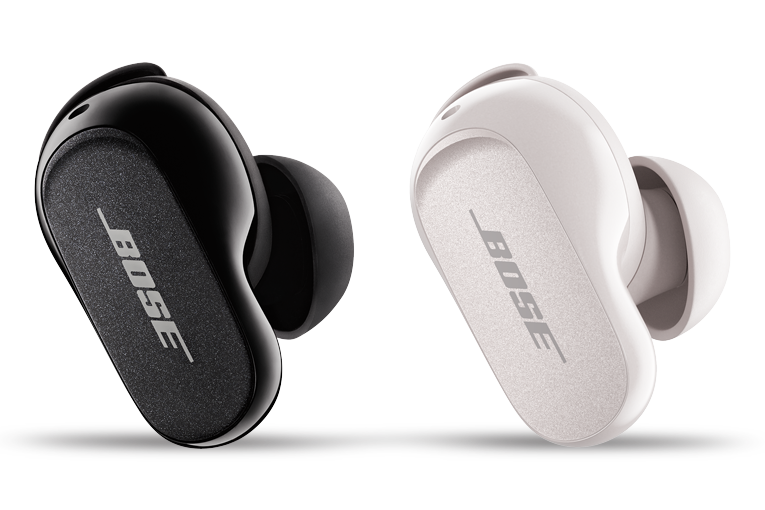
But that noise canceling can’t be overlooked. It really is that good. Believe the hype. When I first got the QC20s, I had everyone I know try them just so they could experience the shock of having the world’s noise disappear with the click of a switch. I did that again with the QCEIIs. They’re that much better.
So I’m not conflicted; I absolutely recommend the QuietComfort Earbuds II if noise canceling is your main desire. I wish there weren’t so many other compromises. They’re just so close to perfect. If you want to give yourself a little zone of quiet to listen to some music, watch a video, or just relax, the Earbuds IIs offer that and more. And for that, $300 seems like a bargain.
. . . Geoffrey Morrison
Associated Equipment
- Smartphones: Google Pixel 5, Google Pixel 7.
- Laptop: Microsoft Surface Pro 8.
Bose QuietComfort Earbuds II True Wireless Earphones
Price: $299.
Warranty: One year.
Bose
The Mountain, Framingham, MA 01701
Phone: (508) 879-7330
Email:
Website: www.bose.com







